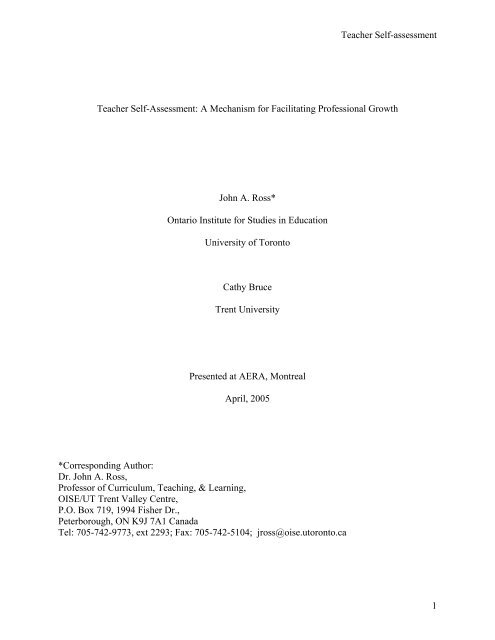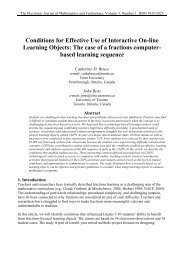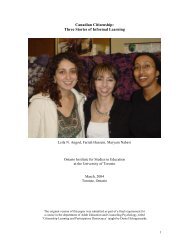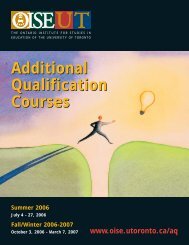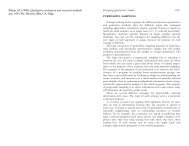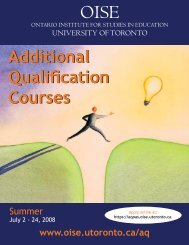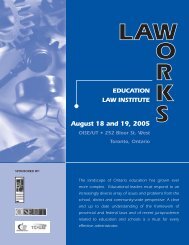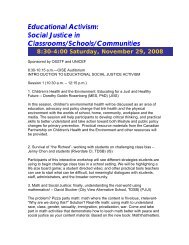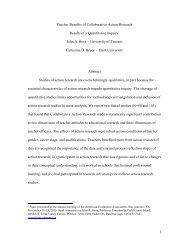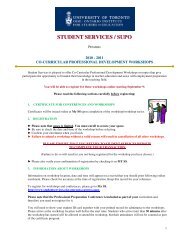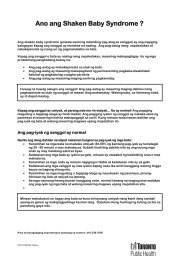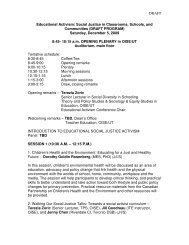Teacher Self-Assessment - Ontario Institute for Studies in Education ...
Teacher Self-Assessment - Ontario Institute for Studies in Education ...
Teacher Self-Assessment - Ontario Institute for Studies in Education ...
You also want an ePaper? Increase the reach of your titles
YUMPU automatically turns print PDFs into web optimized ePapers that Google loves.
<strong>Teacher</strong> <strong>Self</strong>-assessment<strong>Teacher</strong> <strong>Self</strong>-<strong>Assessment</strong>: A Mechanism <strong>for</strong> Facilitat<strong>in</strong>g Professional GrowthJohn A. Ross*<strong>Ontario</strong> <strong>Institute</strong> <strong>for</strong> <strong>Studies</strong> <strong>in</strong> <strong>Education</strong>University of TorontoCathy BruceTrent UniversityPresented at AERA, MontrealApril, 2005*Correspond<strong>in</strong>g Author:Dr. John A. Ross,Professor of Curriculum, Teach<strong>in</strong>g, & Learn<strong>in</strong>g,OISE/UT Trent Valley Centre,P.O. Box 719, 1994 Fisher Dr.,Peterborough, ON K9J 7A1 CanadaTel: 705-742-9773, ext 2293; Fax: 705-742-5104; jross@oise.utoronto.ca1
<strong>Teacher</strong> <strong>Self</strong>-assessment<strong>Teacher</strong> <strong>Self</strong>-<strong>Assessment</strong>: A Mechanism <strong>for</strong> Facilitat<strong>in</strong>g Professional GrowthAbstract<strong>Self</strong>-assessment is a powerful technique <strong>for</strong> improv<strong>in</strong>g achievement. In this article weoutl<strong>in</strong>e a theory of teacher change that l<strong>in</strong>ks self-assessment by teachers to their professionalgrowth. This theory provides avenues <strong>for</strong> peers and change agents to <strong>in</strong>fluence teacher practice.We apply the theory to change <strong>in</strong> mathematics teach<strong>in</strong>g and report an explanatory case study <strong>in</strong>which use of the self-assessment tool, <strong>in</strong> comb<strong>in</strong>ation with other elements, contributed to change<strong>in</strong> the <strong>in</strong>structional practice of a grade 8 mathematics teacher. Provision of a self-assessmenttool contributed to teacher growth by: 1) <strong>in</strong>fluenc<strong>in</strong>g the teacher’s def<strong>in</strong>ition of excellence <strong>in</strong>teach<strong>in</strong>g and <strong>in</strong>creas<strong>in</strong>g his ability to recognize mastery experiences; 2) help<strong>in</strong>g the teacherselect improvement goals by provid<strong>in</strong>g him with clear standards of teach<strong>in</strong>g, opportunities tof<strong>in</strong>d gaps between desired and actual practices, and a menu of options <strong>for</strong> action; 3) facilitat<strong>in</strong>gcommunication with the teacher’s peer, and 4) <strong>in</strong>creas<strong>in</strong>g the <strong>in</strong>fluence of external changeagents on teacher practice. The study argues that provid<strong>in</strong>g a self-assessment tool is aconstructive strategy <strong>for</strong> improv<strong>in</strong>g the effectiveness of <strong>in</strong>-service provided it is bundled withother professional growth strategies: peer coach<strong>in</strong>g, observation by external change agents, andfocused <strong>in</strong>put on teach<strong>in</strong>g strategies.2
<strong>Teacher</strong> <strong>Self</strong>-assessment<strong>Teacher</strong> <strong>Self</strong>-<strong>Assessment</strong>: A Mechanism <strong>for</strong> Facilitat<strong>in</strong>g Professional Growth 1<strong>Self</strong>-assessment is a powerful technique <strong>for</strong> self-improvement. Teach<strong>in</strong>g students how toself-assess contributes to more accurate self-assessment and to higher student achievement(Arter, Spandel, Culham, & Pollard, 1994; McDonald & Boud, 2003; Ross, Rolheiser, &Hogaboam-Gray, 1999; 2002-b; Ross & Starl<strong>in</strong>g, <strong>in</strong> press). In this article we outl<strong>in</strong>e a theory ofteacher change <strong>in</strong> which self-assessment is a mechanism <strong>for</strong> professional growth that providesavenues <strong>for</strong> peers and change agents to <strong>in</strong>fluence teacher practice. Because it providesopportunities <strong>for</strong> <strong>in</strong>fluence, it is a hitherto neglected strategy <strong>for</strong> facilitat<strong>in</strong>g professional growth.We apply the theory to change <strong>in</strong> mathematics teach<strong>in</strong>g and report an explanatory case study <strong>in</strong>which use of the self-assessment tool, <strong>in</strong> comb<strong>in</strong>ation with other elements, contributed to change<strong>in</strong> a grade 8 teacher.Theoretical FrameworkTheory of Individual <strong>Teacher</strong> ChangeWe began the study with the model of teacher change <strong>in</strong> Figure 1, a model heavily<strong>in</strong>fluenced by social cognition theory (Bandura, 1997) and by our work on student selfassessment(particularly Ross et al., 2002-b). It proposes that teacher change occurs throughreflection on experience and that self-efficacy beliefs mediate the <strong>in</strong>fluence of self-assessment onteacher practice.Figure 1 Here1 The research was funded by the <strong>Ontario</strong> M<strong>in</strong>istry of <strong>Education</strong> and Tra<strong>in</strong><strong>in</strong>g and by the SocialSciences and Humanities Research Council. The article does not necessarily reflect the views ofthe M<strong>in</strong>istry or the Council. The rubric <strong>for</strong> standards-based mathematics teach<strong>in</strong>g and the selfassessmenttool were created by John Ross, Doug McDougall, Anne Hogaboam-Gray, CathyBruce, Sonia Ben Jafaar, Jane Lee and Ann LeSage, with website design by Carolyn Brioux.3
<strong>Teacher</strong> <strong>Self</strong>-assessmentAt the centre of Figure 1 are teacher cognitions about their practice, particularly theirperceptions of its effectiveness <strong>in</strong> br<strong>in</strong>g<strong>in</strong>g about student learn<strong>in</strong>g. The model represents selfassessmentas the <strong>in</strong>tegration of three processes that self-regulat<strong>in</strong>g professionals use to observeand <strong>in</strong>terpret their behavior. First, teachers produce self-observations, focus<strong>in</strong>g on aspects of<strong>in</strong>struction relevant to their subjective standards of success. Second, teachers make selfjudgments<strong>in</strong> which they determ<strong>in</strong>e how well their general and specific goals were met. Theprimary data are teacher perceptions of changes <strong>in</strong> student per<strong>for</strong>mance gleaned from studentutterances, work on classroom assignments, homework, and <strong>for</strong>mal assessments. Third, are selfreactions,<strong>in</strong>terpretations of the degree of goal atta<strong>in</strong>ment that express how satisfied teachers arewith the result of their actions. These self-assessments may occur <strong>in</strong> the moment (if the durationof the moment is extended) as reflection-<strong>in</strong>-action or retrospectively as reflection-on-action.<strong>Self</strong>-assessments contribute to teachers’ beliefs about their ability to br<strong>in</strong>g about studentlearn<strong>in</strong>g; i.e., teacher efficacy, a <strong>for</strong>m of professional self-efficacy. <strong>Teacher</strong> efficacy isparticularized to teach<strong>in</strong>g specific content, to particular students, <strong>in</strong> specific <strong>in</strong>structionalcontexts. <strong>Teacher</strong> efficacy is an expectancy about future per<strong>for</strong>mance that is based on pastexperience. <strong>Teacher</strong>s who perceive they have been successful, regardless of the accuracy of theirjudgment, expect to be successful <strong>in</strong> the future. Of the four sources of teacher efficacy<strong>in</strong><strong>for</strong>mation identified by Bandura (1997), the most powerful is mastery experience—be<strong>in</strong>gsuccessful <strong>in</strong> the classroom. <strong>Teacher</strong>s become confident about their future per<strong>for</strong>mance whenthey believe that through their own actions they have helped children learn.<strong>Teacher</strong> efficacy <strong>in</strong>fluences goal sett<strong>in</strong>g and ef<strong>for</strong>t expenditure. <strong>Teacher</strong>s who anticipatethat they will be successful set higher goals <strong>for</strong> themselves and their students. <strong>Teacher</strong> efficacyconsistently predicts will<strong>in</strong>gness to try out new teach<strong>in</strong>g ideas, particularly techniques that are4
<strong>Teacher</strong> <strong>Self</strong>-assessmentdifficult to implement and <strong>in</strong>volve risks such as shar<strong>in</strong>g control with students (e.g., Ross, 1992-b). High expectations of success motivate classroom experimentation because teachers anticipatethey will be able to achieve the benefits of <strong>in</strong>novation and overcome obstacles that might arise.<strong>Teacher</strong>s with high expectations about their ability to teach produce higher student achievement(Goddard, Hoy, & Hoy, 2004; Herman, Meece, & McCombs, 2000; Mascall, 2003; Muijs &Reynolds, 2001; Ross, 1992-b; Ross & Cous<strong>in</strong>s, 1993). <strong>Teacher</strong> efficacy contributes toachievement because high efficacy teachers try harder, use management strategies that stimulatestudent autonomy, attend more closely to low ability student needs, and modify students’ abilityperceptions (evidence reviewed <strong>in</strong> Ross, 1998).<strong>Teacher</strong> efficacy also <strong>in</strong>fluences ef<strong>for</strong>t. <strong>Teacher</strong>s with high teacher efficacy have fewerabsences (Imants & Van Zoelen, 1995), are more will<strong>in</strong>g to handle difficult to teach studentsthemselves rather than refer them to special classes (Soodak & Podell, 1998), and are less likely toleave the profession (Brouwers & Tomic, 2000; Johnson & Birkeland, 2003). Confident teacherspersist. They are not depressed by failure but respond to setbacks with renewed ef<strong>for</strong>t (Bandura,1997).Goal sett<strong>in</strong>g and ef<strong>for</strong>t expenditure are l<strong>in</strong>ked: For example, <strong>in</strong>dividuals are more likelyto persist if they adopt goals that have unambiguous outcomes, that are achievable <strong>in</strong> the nearfuture, and that are moderately difficult to achieve (Schunk, 1981).The comb<strong>in</strong>ation of goals and ef<strong>for</strong>t affect teacher practice def<strong>in</strong>ed as the assembly ofteacher actions (e.g., choice of curriculum objectives, teach<strong>in</strong>g methods, assessment) andknowledge (e.g., of subjects, learners, pedagogy, and policy). <strong>Teacher</strong>s will<strong>in</strong>g to try new<strong>in</strong>structional ideas and persist through obstacles are more likely to implement new approaches,experience success with them, and <strong>in</strong>ternalize the <strong>in</strong>novations <strong>in</strong>to their practice. There may also5
<strong>Teacher</strong> <strong>Self</strong>-assessmentbe benefits <strong>for</strong> professional learn<strong>in</strong>g. Research with children suggests that positive selfevaluationsfoster an upward cycle of learn<strong>in</strong>g <strong>in</strong> which the child sets higher goals and commitsmore personal resources to learn<strong>in</strong>g tasks. Negative self-evaluations lead students to adopt socialrather than academic self-images (Anderman, Anderman, & Gries<strong>in</strong>ger, 1999), embrace goalorientations that conflict with learn<strong>in</strong>g, select personal goals that are unrealistic, adopt learn<strong>in</strong>gstrategies which are <strong>in</strong>effective, exert low ef<strong>for</strong>t, and make excuses <strong>for</strong> per<strong>for</strong>mance (Stipek,Recchia, & McCl<strong>in</strong>tic, 1992).In summary, our theory of teacher change is based on teacher self-assessment with<strong>in</strong> thebroader framework of social cognition theory. What matters is not the absolute level ofclassroom success but teachers’ <strong>in</strong>terpretation of experience. <strong>Self</strong>-assessment contributes toexpectations that guide goal sett<strong>in</strong>g and ef<strong>for</strong>t.The Influence of Peers on <strong>Teacher</strong> <strong>Self</strong>-<strong>Assessment</strong><strong>Self</strong>-assessment, an <strong>in</strong>dividual enterprise, can be <strong>in</strong><strong>for</strong>med by colleagues. Peer <strong>in</strong>put can<strong>in</strong>fluence the first self-assessment process (self-observation) by direct<strong>in</strong>g teacher attention toparticular dimensions of practice. Peer feedback might <strong>in</strong>fluence teacher judgments about thedegree of their goal atta<strong>in</strong>ment (the second process). The <strong>in</strong>fluence is likely to be stronger ifcolleagues <strong>in</strong>terpret student outcomes and teacher practices <strong>in</strong> terms of overt standards. Peersmight <strong>in</strong>fluence teacher satisfaction with the outcomes of their <strong>in</strong>struction (the third process), ifcolleagues give praise explicitly l<strong>in</strong>ked to the quality of the teacher’s per<strong>for</strong>mance (Cameron &Pierce, 1994). Peer feedback is weighed aga<strong>in</strong>st the observations, judgments and reactions theteacher generates dur<strong>in</strong>g (i.e., reflection-<strong>in</strong>-action) and after (i.e., reflection-on-action) the lesson.Peer <strong>in</strong>put may complement or compete with these self-responses depend<strong>in</strong>g upon the teacher’sperceptions of the credibility of their colleagues.6
<strong>Teacher</strong> <strong>Self</strong>-assessmentThese opportunities <strong>for</strong> peer <strong>in</strong>fluences on teacher self-assessment that contribute to selfefficacy<strong>in</strong>volve recogniz<strong>in</strong>g teach<strong>in</strong>g success (mastery experiences). Peers also haveopportunities to <strong>in</strong>fluence teacher efficacy through the other three sources of efficacy<strong>in</strong><strong>for</strong>mation proposed by Bandura (1997): social persuasion (tell<strong>in</strong>g colleagues they are capableof per<strong>for</strong>m<strong>in</strong>g a task), vicarious experience (highlight<strong>in</strong>g the successful per<strong>for</strong>mance of someonesimilar to the teacher), and manag<strong>in</strong>g physiological and emotional states (strengthen<strong>in</strong>g positivefeel<strong>in</strong>gs aris<strong>in</strong>g from teach<strong>in</strong>g and <strong>in</strong>terpret<strong>in</strong>g them as <strong>in</strong>dicative of teach<strong>in</strong>g ability or reduc<strong>in</strong>gnegative feel<strong>in</strong>gs aris<strong>in</strong>g from teach<strong>in</strong>g, such as stress).Peers can also <strong>in</strong>fluence teacher practice by suggest<strong>in</strong>g specific strategies and by work<strong>in</strong>gtogether to implement them. Collaboration among teachers promotes teacher efficacy (e.g.,Chester & Beaud<strong>in</strong>, 1996), especially when it leads to <strong>in</strong>structional coord<strong>in</strong>ation with<strong>in</strong> a school(e.g., Raudenbush, Rowan, & Cheong, 1992).Norms of privatized practice typically limit peer opportunities <strong>for</strong> <strong>in</strong>fluenc<strong>in</strong>g teacherself-assessments. Norms of isolation can be overcome by creat<strong>in</strong>g professional schoolcommunities with shared values, collaborative action, deprivatized practice and reflectivedialogue (Louis & Marks, 1998). A structured approach <strong>for</strong> do<strong>in</strong>g this is peer coach<strong>in</strong>g--pairs ofteachers of equal experience and competence observe each other teach, negotiate improvementgoals, devise strategies to implement the goals, observe the improved teach<strong>in</strong>g, and provide eachother with feedback. Coach<strong>in</strong>g has positive effects when the appropriate climate, <strong>in</strong>volv<strong>in</strong>gmutual trust, genu<strong>in</strong>e voluntarism, encouragement of reflective th<strong>in</strong>k<strong>in</strong>g, and pr<strong>in</strong>cipal support(McLymont & da Costa, 1998) is developed. Peer coach<strong>in</strong>g <strong>in</strong>creases teacher implementation ofsought-after teach<strong>in</strong>g practices and contributes to higher teacher efficacy (Kohler, Ezell, &Paluselli, 1999; Licklider, 1995; W<strong>in</strong>eburg, 1995).7
<strong>Teacher</strong> <strong>Self</strong>-assessmentWhen teachers re<strong>in</strong><strong>for</strong>ce each other, beliefs about competence are magnified. Collectiveteacher efficacy is “the perceptions of teachers <strong>in</strong> a school that the ef<strong>for</strong>ts of the faculty as a wholewill have a positive effect on students” (Goddard, Hoy, & Hoy, 2000, p. 480). Schools with highcollective teacher efficacy have higher student achievement than schools with lower levels ofcollective teacher efficacy, <strong>in</strong>dependent of student socio-economic status (e.g., Goddard, 2001;2002b; Goddard et al., 2000). Peers exert a powerful <strong>in</strong>fluence on the collective teacher efficacyof a school.In summary, the <strong>in</strong>dividual process of teacher change can be <strong>in</strong>fluenced by teachers’peers. The avenues <strong>for</strong> <strong>in</strong>fluence are embedded <strong>in</strong> the self-assessment process and <strong>in</strong> othermechanisms identified <strong>in</strong> social cognition theory such as persuasion and vicarious experience.But these avenues need to be developed through professional community development activitiessuch as peer coach<strong>in</strong>g.Influence of External Change Agents on <strong>Teacher</strong> ChangeExternal change agents, <strong>for</strong> example, university researchers, can <strong>in</strong>fluence teacher selfassessmentthrough the same mechanisms potentially available to peers. Although lack ofimmediacy, presence, and shared values dim<strong>in</strong>ishes the <strong>in</strong>fluence of external agents, universitybasedchange agents can contribute to teacher self-assessment by clarify<strong>in</strong>g goals (i.e.,dimensions of teach<strong>in</strong>g that def<strong>in</strong>e excellence) and criteria (levels of per<strong>for</strong>mance that constitutea hierarchy of professional growth). They can also provide credible feedback on whetherparticular standards of teach<strong>in</strong>g have been achieved (e.g., through classroom observation).Researchers can also provide teachers with <strong>in</strong><strong>for</strong>mation about means—specific strategies that arecredibly l<strong>in</strong>ked to subject standards that are likely to lead to higher achievement8
<strong>Teacher</strong> <strong>Self</strong>-assessmentApplication to MathematicsWe selected mathematics as the doma<strong>in</strong> <strong>for</strong> test<strong>in</strong>g our theory of teacher self-assessmentbecause the field dist<strong>in</strong>guishes clearly between standards-based teach<strong>in</strong>g and traditional methods;there is evidence that the <strong>for</strong>mer has greater student achievement effects than the latter; andimplementation of math education re<strong>for</strong>m is a challeng<strong>in</strong>g school improvement problem. Withimplementation of standards-based mathematics teach<strong>in</strong>g, problem solv<strong>in</strong>g and conceptualunderstand<strong>in</strong>g improve without any loss of computational mastery (Hickey, Moore, &Pellegr<strong>in</strong>o, 2001; Riordan & Noyce, 2001; Wood & Sellers, 1997). Yet research (reviewed <strong>in</strong>Ross, McDougall, & Hogaboam-Gray, 2002, 2002) suggests that change <strong>in</strong> mathematicsclassrooms is problematic. For example, teachers must be agents of a change they did notexperience as students (Anderson & Piazza, 1996).Our review of math education research (Ross et al., 2002) and National Council of<strong>Teacher</strong>s of Mathematics policy statements (NCTM 1989; 1991; 2000) identified tencharacteristics of standards-based mathematics teach<strong>in</strong>g. We constructed a rubric fromobservations and <strong>in</strong>terviews with teachers who ranged from traditional to high fidelityimplementers of standards-based mathematics teach<strong>in</strong>g (McDougall, Lawson, Ross, MacLellan,Kajander & Scane, 2000; Ross, Hogaboam-Gray, McDougall, & Bruce, 2001; Ross &McDougall., 2003). For each of our 10 dimensions, we described four levels of implementation,arranged <strong>in</strong> a hierarchy of <strong>in</strong>creas<strong>in</strong>g fidelity to NCTM Standards. Table 1 illustrates the rubric.The Table shows four levels describ<strong>in</strong>g the “transparency” of student evaluation; i.e., the extentto which the teacher’s procedures and criteria <strong>for</strong> evaluation are revealed to students. Thevalidity of the hierarchy of levels was established by a panel of content experts (Ross et al.,2003). We created a self-report survey from the rubric to produce evidence of the validity of the9
<strong>Teacher</strong> <strong>Self</strong>-assessmentsurvey and the rubric. The evidence consisted of correlations of survey scores with a mandatedper<strong>for</strong>mance assessment, congruence with classroom observations of teachers, anddemonstrations that teachers who were similar <strong>in</strong> their claims about us<strong>in</strong>g a standards-based textseries differed <strong>in</strong> how they used the text, <strong>in</strong> ways predicted by the survey (Ross et al., 2003).The self-assessment tool consists of four short descriptions (derived from the rubric) <strong>for</strong>each of the 10 dimensions of Standards-based mathematics teach<strong>in</strong>g. <strong>Teacher</strong>s access the toolthrough an <strong>in</strong>teractive website (URL removed <strong>for</strong> bl<strong>in</strong>d review). The teacher makes 18 decisionsand receives immediate feedback. The website provides teachers with an overall score <strong>in</strong> termsof four categories rang<strong>in</strong>g from “procedures focus”, correspond<strong>in</strong>g to traditional mathematics<strong>in</strong>struction, to “exploration focus”, correspond<strong>in</strong>g to standards-based mathematics teach<strong>in</strong>g.<strong>Teacher</strong>s also receive a summary of their responses to all items.Case StudyWe tested the utility of self-assessment as a device <strong>for</strong> teacher change with data collected<strong>in</strong> a qualitative study of ten grade 7-9 teachers engaged over a three-month period <strong>in</strong> an <strong>in</strong>serviceprogram to <strong>in</strong>crease implementation of standards-based teach<strong>in</strong>g (Ross & McDougall,2003). The <strong>in</strong>tervention had four components: 1) teacher self-assessment and 2) the teach<strong>in</strong>grubric, both described above. 3) In<strong>for</strong>mation on how to implement the Standards based on the PDStandards <strong>for</strong> Elementary Mathematics identified by Hill (2004): teachers constructedmathematical mean<strong>in</strong>g by engag<strong>in</strong>g <strong>in</strong> mathematical tasks and content comparable to thoseundertaken by their students; the <strong>in</strong>-service focused on classroom practice (e.g., teachersexam<strong>in</strong>ed examples of student work from their own classes and classes of their peers); teachersworked together, rather than alone, on <strong>in</strong>-service tasks; <strong>in</strong>-service presenters modeled therecommended <strong>in</strong>structional practices; the <strong>in</strong>-service focused on student learn<strong>in</strong>g, illustrat<strong>in</strong>g how10
<strong>Teacher</strong> <strong>Self</strong>-assessmentstudents learn mathematics; classroom teachers participated <strong>in</strong> the design and delivery of the <strong>in</strong>service.These standards contribute to teacher learn<strong>in</strong>g (Brandes & Erickson, 1998; Garet, Porter,Desimone, Birman, & Yoon, 2001; Loucks-Horsley & Matsumoto, 1999). 4) Peer coach<strong>in</strong>g <strong>in</strong>which pairs of teachers observed each other teach, collectively set professional goals,implemented the goals <strong>in</strong>dividually, and observed changes <strong>in</strong> each other’s classroom practice.Coach<strong>in</strong>g has positive effects when the appropriate climate, <strong>in</strong>volv<strong>in</strong>g mutual trust, genu<strong>in</strong>evoluntarism, encouragement of reflective th<strong>in</strong>k<strong>in</strong>g, and pr<strong>in</strong>cipal support (McLymont & daCosta, 1998) is developed. Peer coach<strong>in</strong>g <strong>in</strong>creases teacher implementation of sought-afterteach<strong>in</strong>g practices and contributes to higher teacher efficacy (Kohler, Ezell, & Paluselli, 1999;Licklider, 1995; W<strong>in</strong>eburg, 1995). The events of the <strong>in</strong>tervention were: 1) <strong>in</strong>dividual selfassessmentus<strong>in</strong>g an <strong>in</strong>teractive website; 2) <strong>in</strong>-service on peer observation skills and teach<strong>in</strong>gstrategies <strong>for</strong> Standards application; 3) peer observation of teach<strong>in</strong>g, 4) <strong>in</strong>-service on use of peerobservation data and <strong>in</strong>put on teach<strong>in</strong>g strategies; 5) classroom experimentation over 4 weeks; 6)peer observation, and 7) <strong>in</strong>-service on teach<strong>in</strong>g strategies.For this article we purposefully selected the teacher who most benefited from the<strong>in</strong>tervention. The study is an explanatory case study; i.e., it provides the best evidence that wehave of the cause-effect relationships represented <strong>in</strong> Figure 1. The mechanisms that wereoperat<strong>in</strong>g <strong>in</strong> our explanatory case were present <strong>in</strong> the other cases, albeit to a lesser degree (seeURL removed <strong>for</strong> bl<strong>in</strong>d review). We used pattern match<strong>in</strong>g (Mark, Henry, & Julnes, 2000) <strong>in</strong>which we compared hypothesized to observed events to test the claim that self-assessmentcontributes to professional growth. In do<strong>in</strong>g so we contrasted the mechanisms hypothesized <strong>in</strong>Figure 1 with a simpler model <strong>in</strong> which teacher change was attributed to provid<strong>in</strong>g teachers with<strong>in</strong><strong>for</strong>mation on how to teach mathematics from a standards-based perspective. This simpler11
<strong>Teacher</strong> <strong>Self</strong>-assessmentmodel assumes that teachers are not implement<strong>in</strong>g re<strong>for</strong>m mathematics because they lackpedagogical content knowledge.MethodsBarry was a grade 8 teacher <strong>in</strong> a grade 7-8 <strong>Ontario</strong>, Canada school who taught five mathclasses and a homeroom class. The school served 300 urban and rural pupils from a range ofeconomic backgrounds. Barry was a seasoned mathematics teacher, recognized <strong>for</strong> his expertise<strong>in</strong> the school and district. His teach<strong>in</strong>g partner was Mark, a grade 7 teacher <strong>in</strong> the same schoolwho taught several Grade 7 mathematics classes and a homeroom class.We observed Barry on five occasions (observations 1 and 5 were two day events; therema<strong>in</strong>der were one day).Site visits followed procedures established by Simon and Tzur (1999).We visited Barry’s classroom <strong>in</strong> September on two consecutive days dur<strong>in</strong>g his math period (75-80 m<strong>in</strong>utes per day). We <strong>in</strong>terviewed him be<strong>for</strong>e, dur<strong>in</strong>g, and after each math lesson to elicit his<strong>in</strong>tentions and reflections on the lessons we observed. We recorded key events and contextualdetail. The purposes of the second day of observations were: a) to ensure that as manydimensions of teach<strong>in</strong>g as possible were observed; b) to determ<strong>in</strong>e Barry’s consistency; c) toguard aga<strong>in</strong>st demonstration lessons. Observations of mathematics teach<strong>in</strong>g (by Barry, his peer,and researchers) were coded us<strong>in</strong>g the categories of the rubric (4 levels X 10 dimensions ofteach<strong>in</strong>g), us<strong>in</strong>g the template shown <strong>in</strong> the Appendix. The data consisted of the self-assessment,our classroom observations, Mark’s peer observation reports, <strong>in</strong>dividual and collective<strong>in</strong>terviews, correspondence with Barry, Barry’s response to our 10-page case report, and fieldnotes of <strong>in</strong>-service sessions.Analysis was guided by three questions: In what ways did Barry th<strong>in</strong>k he had changed?To what extent did our observations confirm or disconfirm Barry’s claims about change? What12
<strong>Teacher</strong> <strong>Self</strong>-assessmentfactors contributed to or impeded change? We developed codes (N=28), shown <strong>in</strong> the Appendix,based on the questions and used NUD*IST to organize the data. Themes were developed throughconstant comparison. Credibility of the f<strong>in</strong>d<strong>in</strong>gs was enhanced by 1) triangulat<strong>in</strong>g between datacollection times and <strong>in</strong>terpreters (Creswell, 1998); 2) ma<strong>in</strong>ta<strong>in</strong><strong>in</strong>g an audit trail by creat<strong>in</strong>g chartsof relationships and count<strong>in</strong>g <strong>in</strong>stances (Miles & Hubberman, 1994); 3) search<strong>in</strong>g <strong>for</strong> evidence ofalternative theories; i.e., test<strong>in</strong>g the alternate hypothesis that provision of pedagogical contentknowledge is sufficient <strong>for</strong> teacher change (Mark et al., 2000); 4) us<strong>in</strong>g member checks,particularly teacher feedback on the short case reports (Creswell, 1998).ResultsBarry’s Action Plan Barry’s self-perception on entry to the project and the results of hisweb-based self-assessment were <strong>in</strong> agreement, lead<strong>in</strong>g Barry to summarize his teach<strong>in</strong>g approachas: “The kids explore, but mostly on my terms. I’m at a level 3 (modified exploration focus) withsome signs of level 4 (exploration focus).” Initial observations matched this <strong>in</strong>terpretation. Barryencouraged problem solv<strong>in</strong>g and <strong>in</strong>tegration of different types of mathematics us<strong>in</strong>g rich learn<strong>in</strong>gtasks. For example, students applied measurement, geometry and number concepts and skills todesign a camp. He deepened understand<strong>in</strong>g through multiple and varied opportunities to explorespecific concepts and skills. For example, after conduct<strong>in</strong>g surveys and participat<strong>in</strong>g <strong>in</strong> a wholegroup data management task, students were given a series of statements to explore, such as “Onaverage, Canadians open their refrigerators 22 times a day.” Students had to create amathematical rationale as to whether they thought each statement was reasonable orunreasonable.Barry chose to focus on Dimension 8: Student-Student Interaction and Dimension 9:Student <strong>Assessment</strong> (especially transparency of assessment, illustrated <strong>in</strong> Table 1), see<strong>in</strong>g these13
<strong>Teacher</strong> <strong>Self</strong>-assessmentas relative weaknesses <strong>in</strong> his program. This article will focus on the student assessment aspect ofhis action plan as an illustrative example.Dur<strong>in</strong>g our <strong>in</strong>itial observations Barry used a range of high quality assessment strategies.Each student kept a portfolio conta<strong>in</strong><strong>in</strong>g rubrics <strong>for</strong> assess<strong>in</strong>g specific tasks, anecdotal commentsmade by the teacher on student work, end of unit student reflections and end of unit culm<strong>in</strong>at<strong>in</strong>gtasks. A typical written comment <strong>in</strong>cluded: “I’m glad you’re enjoy<strong>in</strong>g math so far. You need amore complete write-up of the humm<strong>in</strong>gbird experiment.” We observed Barry us<strong>in</strong>g a rubricwhile students presented their data displays <strong>in</strong> class. Dur<strong>in</strong>g the <strong>in</strong>itial <strong>in</strong>terview, Barry <strong>in</strong>dicatedthat he provided students with rubrics <strong>for</strong> per<strong>for</strong>mance assessments, but not <strong>for</strong> tests. Heprovided examples of his practice that <strong>in</strong>dicated that his purposes <strong>for</strong> student assessment<strong>in</strong>cluded report<strong>in</strong>g to parents, improvement of student learn<strong>in</strong>g, ref<strong>in</strong>ement of teach<strong>in</strong>g methodsand curriculum modification. Barry’s self-assessment was confirmatory <strong>in</strong> that it placed himtoward the high end on the subdimensions “variety of assessments” and “purpose ofassessments” but it also highlighted an aspect of Barry’s practice that he wanted to change.Although Barry used assessment rubrics he did not <strong>in</strong>volve students <strong>in</strong> their development,someth<strong>in</strong>g he saw Mark do<strong>in</strong>g dur<strong>in</strong>g the peer observation. Barry’s plan was to developassessment tools collaboratively with students, mak<strong>in</strong>g assessment a more transparent process,and shift<strong>in</strong>g from a teacher-directed assessment to more student-directed assessment. Markexpressed confidence that Barry would be successful <strong>in</strong> chang<strong>in</strong>g his assessment practice.Implementation of Barry’s Action Plan Barry embarked on a Fermi Problem Solv<strong>in</strong>g unit. (AFermi problem generally requires estimation of physical quantities. These problems challengestudents to ask more questions, def<strong>in</strong>e the parameters of their solution and determ<strong>in</strong>ereasonableness, not just provide an answer.)14
<strong>Teacher</strong> <strong>Self</strong>-assessmentBarry began the unit by negotiat<strong>in</strong>g with students a rubric <strong>for</strong> problem solv<strong>in</strong>g, adapt<strong>in</strong>g astrategy presented at the second <strong>in</strong>-service session. His strategy had three phases. In the firstphase, students <strong>in</strong>dividually bra<strong>in</strong>stormed responses to questions like “when I am solv<strong>in</strong>gproblems <strong>in</strong> Math, it is helpful when…If our class was problem solv<strong>in</strong>g <strong>in</strong> small groups, anobserver would hear…” In groups of 3-4 without teacher <strong>in</strong>tervention, students created graffiticharts to organize and display their responses. In the second phase, students worked <strong>in</strong> groups tosolve a rich problem. Dur<strong>in</strong>g the 75 m<strong>in</strong>utes it took to complete the problem four studentsobserved problem solv<strong>in</strong>g behaviors. The observers used a T-Chart labeled: “What I hear <strong>in</strong> theproblem solv<strong>in</strong>g sett<strong>in</strong>g” and “What I see <strong>in</strong> the problem solv<strong>in</strong>g sett<strong>in</strong>g”. In the third phase,Barry shared a set of five criteria <strong>for</strong> assess<strong>in</strong>g student problem solv<strong>in</strong>g (from prov<strong>in</strong>cialassessment policy). In small groups, students created descriptors <strong>for</strong> each criterion, draw<strong>in</strong>g uponthe vocabulary of their graffiti and T-charts. The f<strong>in</strong>al rubric was posted across one full wall <strong>in</strong>the classroom. Barry told students that they would be evaluated based on these descriptions.In subsequent classes we observed Barry open<strong>in</strong>g the lesson by review<strong>in</strong>g the criteria <strong>for</strong>evaluation of problem solv<strong>in</strong>g activity.T: What will I be look<strong>in</strong>g <strong>for</strong> today?St: On task, quiet work.T: What k<strong>in</strong>d of work?Sts: Various students referred to specific components of the rubric on the side wall todescribe the k<strong>in</strong>ds of work the teacher would be look<strong>in</strong>g <strong>for</strong>.T: So I will be look<strong>in</strong>g to see how you work with your partner. I’ll be do<strong>in</strong>g that on mytracker.15
<strong>Teacher</strong> <strong>Self</strong>-assessmentAfter this class, the teacher wrote a note to each small group about his observations oftheir <strong>in</strong>teractions and related the observations to the class rubric. For example:Jessica and Soroya [level 3 of the student rubric, dimension “solution write up”]You were both very focused dur<strong>in</strong>g my observation and were shar<strong>in</strong>g ideas and build<strong>in</strong>gon the ideas of others. 6 solutions was quite a good number <strong>for</strong> the time allotted.Students were observed review<strong>in</strong>g these teacher comments very carefully.In another class we observed Barry tell<strong>in</strong>g students at the start-up which items from thestudent negotiated rubric he would focus on dur<strong>in</strong>g his observations of group work. There was aone m<strong>in</strong>ute review of the rubric on the wall be<strong>for</strong>e students began their work. Dur<strong>in</strong>g thisobservation, student assessment was made explicit and was based on student negotiated criteria.<strong>Teacher</strong> Perceptions of Professional Change When asked whether his practice hadchanged with regard to the transparency of student assessment, Barry said “Over the four weeks[of <strong>in</strong>tervention and observations], I opened th<strong>in</strong>gs up. In May, the survey would change aga<strong>in</strong>.For example, I th<strong>in</strong>k there will be more transparency.” He identified evidence of the effects ofhis change on students, such as “Individual student results <strong>in</strong> problem solv<strong>in</strong>g <strong>in</strong>creased from theprevious unit, students were faster gett<strong>in</strong>g on task [times were recorded]”, and student write-ups[written responses to problems] were more elaborate.”After the end of the project Barry cont<strong>in</strong>ued to work on assessment transparency, as<strong>in</strong>dicated by his notes to the researchers. In April, <strong>for</strong> example, he reported that student work wasscored on a student negotiated rubric <strong>for</strong> a unit based on the theme of the human body. In thesame month, Barry gave a workshop to teachers <strong>in</strong> his district on his strategies <strong>for</strong> creat<strong>in</strong>gtransparency <strong>in</strong> student assessment. In June Barry reported: “Over the summer, I hope to ref<strong>in</strong>esome of the tasks that we used <strong>in</strong> the earlier phases of the project and use them right at the start16
<strong>Teacher</strong> <strong>Self</strong>-assessmentof September…so that the message to the students is clear that I value transparency and a shar<strong>in</strong>gof learn<strong>in</strong>g on the mathematical road.”We agreed with Barry’s judgment. Barry began the project work<strong>in</strong>g at a modifiedexploration focus level <strong>for</strong> the transparency sub-dimension of student assessment (level 3 <strong>in</strong>Table 1). After implementation of his action plan, Barry had shifted his program to anexploration focus on this dimension (level 4).Discussion of the Case<strong>Self</strong>-<strong>Assessment</strong> as an Enabl<strong>in</strong>g Factor <strong>in</strong> Professional Growth No previous study hasexplored teacher self-assessment as a mechanism <strong>for</strong> teacher change. The data from the caseprovides considerable support <strong>for</strong> the mechanisms <strong>in</strong> Figure 1. First, the web-based selfassessmentaffected Barry’s <strong>in</strong>ternal self-assessment by modify<strong>in</strong>g his def<strong>in</strong>ition of excellence <strong>in</strong>mathematics teach<strong>in</strong>g. The self-assessment tool identified specific dimensions he could attend to<strong>in</strong> judg<strong>in</strong>g his work and provided descriptions of teach<strong>in</strong>g to which he could compare hisper<strong>for</strong>mance. The articulation of criteria <strong>for</strong> effective mathematics teach<strong>in</strong>g enhanced Barry’sbeliefs about his competence. Barry scored toward the high end on almost all the scales,<strong>in</strong>clud<strong>in</strong>g the dimensions he chose to work on. (His self-assessment and researcher observationsplaced him slightly lower on the student-student <strong>in</strong>teraction dimension but by the end of thestudy Barry had made visible improvements on it as well.) By modify<strong>in</strong>g Barry’s def<strong>in</strong>ition ofteach<strong>in</strong>g excellence the self-assessment <strong>in</strong>creased Barry’s ability to recognize his success. Thecredibility of the self-assessment was enhanced by its agreement with researcher and peerobservations. In social cognition terms, the self-assessment tool contributed to two sources ofteacher efficacy <strong>in</strong><strong>for</strong>mation: mastery experiences and persuasion.17
<strong>Teacher</strong> <strong>Self</strong>-assessmentSecond, the self-assessment tool helped Barry select improvement goals by provid<strong>in</strong>ghim with clear standards of teach<strong>in</strong>g, opportunities to f<strong>in</strong>d gaps between desired and actualpractices, and a menu of options <strong>for</strong> action. Barry believed that the rubric <strong>for</strong> standards-basedteach<strong>in</strong>g accurately represented the doma<strong>in</strong> of mathematics education and he agreed with thehierarchy <strong>in</strong> which the descriptions of teach<strong>in</strong>g were arranged. He was able to place himselfwith<strong>in</strong> this scheme, recognize discrepancies between his current placement and where he wouldlike to go, and select which gaps to work on first. He perceived the specific goals that heidentified as immediate and feasible. As Barry implemented his action plan he experiencedsuccess. He saw how his actions led to student outcomes he valued. This strengthened Barry’sbeliefs about his competence and renewed his commitment to standards-based teach<strong>in</strong>g.Third, the self-assessment tool, particularly the rubric, facilitated communication betweenBarry and Mark. It provided them with a common language <strong>for</strong> talk<strong>in</strong>g about teach<strong>in</strong>g (i.e., thedimensions), common scales (i.e., the levels of the rubric), and a shared experience (i.e., thenovel experience of compar<strong>in</strong>g their teach<strong>in</strong>g to a variety of scales and receiv<strong>in</strong>g feedback ontheir assessments from peers and researchers). These mechanisms <strong>in</strong>creased the clarity andcredibility of the advice Mark offered to Barry. In addition Barry’s observations of Markprovided Barry with assurance that he was “on the right track”.Fourth, the self-assessment tool <strong>in</strong>creased the <strong>in</strong>fluence of external change agents onBarry, through similar mechanisms identified <strong>for</strong> peer <strong>in</strong>fluence. The key <strong>in</strong>fluence wasexercised by provid<strong>in</strong>g clarity about standards of teach<strong>in</strong>g, which contributed to Barry’s selfefficacybeliefs and to his goal sett<strong>in</strong>g. Barry’s self-efficacy was further heightened by theresearchers’ observations and feedback on his practice. In addition the self-assessment dataenabled the researchers to target dimensions of teach<strong>in</strong>g that were most relevant to Barry’s plan18
<strong>Teacher</strong> <strong>Self</strong>-assessmentand to calibrate the <strong>in</strong>put so that it was <strong>in</strong> Barry’s zone of proximal development (Vygotsky,1978).<strong>Self</strong>-assessment as a Constra<strong>in</strong>t on Professional Growth Barry thought that the selfassessmenttool was too rigid. Although each set of response options <strong>in</strong> the self-assessment is acont<strong>in</strong>uum, the feedback given by the website implied that the underly<strong>in</strong>g metric is an ord<strong>in</strong>alscale. Barry felt his practice overlapped the categories and this lowered the credibility of the selfassessment.In addition, Barry felt that the rubric levels represented such large changes <strong>in</strong>practice that the web-based tool was unsuitable to measure change over short time periods.Ref<strong>in</strong>ement of Our Model of <strong>Teacher</strong> Change Data from the case led us to ref<strong>in</strong>e themodel <strong>in</strong> three ways, as shown <strong>in</strong> Figure 2. First, Barry reported that the changes that he made <strong>in</strong>his <strong>in</strong>structional practice contributed to improved student achievement (e.g., higher scores <strong>in</strong>problem solv<strong>in</strong>g), <strong>in</strong>dependent of any changes that occurred <strong>in</strong> his standards <strong>for</strong> <strong>in</strong>terpret<strong>in</strong>g thequality of their work. We decided to <strong>in</strong>clude student achievement, measured <strong>in</strong>dependently ofteacher <strong>in</strong>terpretations, as an element <strong>in</strong> our model that is a consequence of <strong>in</strong>structional changeand an antecedent of teacher self-assessment. Second, we found that both peers and researcherscontributed to knowledge of <strong>in</strong>novative <strong>in</strong>struction. Researchers contributed to teachers’pedagogical content knowledge through semi-structured <strong>in</strong>-service sessions that demonstratedconstructivist teach<strong>in</strong>g strategies associated with mathematics education re<strong>for</strong>m. Peerscontributed teach<strong>in</strong>g strategies dur<strong>in</strong>g shar<strong>in</strong>g sessions <strong>in</strong> which they described their classroomexperiments. They also responded to researcher presentations with adaptations that peers hadimplemented, read about, or <strong>in</strong>vented on the spot. The assembly of an array of <strong>in</strong>structionalalternatives contributed to goal sett<strong>in</strong>g and to ef<strong>for</strong>t allocation <strong>in</strong> the sense that teachers couldfocus on adapt<strong>in</strong>g specific suggestions as opposed to creat<strong>in</strong>g new teach<strong>in</strong>g strategies out of19
<strong>Teacher</strong> <strong>Self</strong>-assessmentwhole cloth. Third, we recognized that the self-assessment needed to identify deficiencies <strong>in</strong>present practice (<strong>in</strong> Barry’s case the discovery of lack of transparency <strong>in</strong> his assessmentpractice), otherwise there was no reason <strong>for</strong> teacher’s to change.Figure 2 About HereNegative Data We selected Barry as our explanatory case because his experience bestillustrated the causal relationships we wanted to explore. Our rationale was that if theserelationships could not be demonstrated <strong>in</strong> optimal conditions they are probably too weak topursue. Six of the other n<strong>in</strong>e cases <strong>in</strong> the study also manifested positive, albeit smaller changes <strong>in</strong>practice (see Ross & McDougall, 2003). In all cases, we saw some evidence of the effects of theself-assessment tool. For example, all teachers, regardless of their commitment to the project,used the rubric <strong>for</strong> standards-based teach<strong>in</strong>g to set goals and gauge change <strong>in</strong> their teach<strong>in</strong>g.Each of the three cases <strong>in</strong> which teachers did not change <strong>in</strong> the directions <strong>in</strong>creased ourunderstand<strong>in</strong>g of how self-assessment <strong>in</strong>fluences teacher practice. One teacher’s self-assessmentwas higher than was <strong>in</strong>dicated by peer and the researcher observations. This teacher rejectedattempts to provide him with contrary evidence, enjoyed the <strong>in</strong>-service and discussions aboutmathematics teach<strong>in</strong>g, and emerged from the project virtually unchanged (<strong>in</strong> our view—hereported that he had). Our <strong>in</strong>terpretation was that his beliefs about mathematics teach<strong>in</strong>g werecompatible with the assumptions of the project but he never saw the gap between his beliefs andpractice and <strong>for</strong> that reason did not attempt to change. His <strong>in</strong>structional experiments werereplications of exist<strong>in</strong>g practice. Two other teachers, work<strong>in</strong>g as a pair, <strong>in</strong>terpreted their selfassessmentspositively by revers<strong>in</strong>g the direction of the rubric levels—they saw the traditionalfocus pole of each dimension as more desirable than the exploration-focus pole represented byre<strong>for</strong>m. In the peer coach<strong>in</strong>g they consolidated their professional values and constructed a pool20
<strong>Teacher</strong> <strong>Self</strong>-assessmentof traditional <strong>in</strong>structional practices that facilitated their movement away from practicesrecommended <strong>in</strong> the prov<strong>in</strong>cial curriculum. These negative cases ref<strong>in</strong>ed our model <strong>in</strong> that wecame to see teacher change as the outcome of self-assessment grounded <strong>in</strong> credible data anddefensible standards, dissatisfaction with present per<strong>for</strong>mance, access to powerful <strong>in</strong>structionalalternatives, and confidence about one’s ability to implement new <strong>in</strong>struction. In addition wenoted that these conditions were associated with contextual elements that enabled Barry tobenefit from the self-assessment tool: high congruence between his beliefs about mathematicsteach<strong>in</strong>g and the beliefs implicit <strong>in</strong> the self-assessment tool, a history of successful mathteach<strong>in</strong>g, a strong collegial relationship with a peer, and strong support from schooladm<strong>in</strong>istration.Conclusion: Provision of a <strong>Self</strong>-<strong>Assessment</strong> Tool is Constructive But InsufficientThe explanatory case illustrates how self-assessment can contribute to professionalgrowth through the mechanisms <strong>in</strong> our revised model <strong>in</strong> Figure 2. In the case, the self-assessmenttool was bundled with other professional growth strategies: peer coach<strong>in</strong>g, observation byexternal change agents, and focused <strong>in</strong>put on teach<strong>in</strong>g strategies.Giv<strong>in</strong>g teachers access to a self-assessment tool without these supports will likelyproduce weaker outcomes. Without the consistency checks provided by feedback from peers orothers, some teachers will generate <strong>in</strong>flated self-appraisals that reduce motivation to change. Forexample, a meta-analysis of 48 studies found that adult students rated their per<strong>for</strong>mance almosthalf a standard deviation higher than <strong>in</strong>structors (Falchikov & Boud, 1989).<strong>Teacher</strong>s who under-rate their per<strong>for</strong>mance or who accurately appraise themselves as lowper<strong>for</strong>mers are also unlikely to change due to the depress<strong>in</strong>g effect of negative self-assessment21
<strong>Teacher</strong> <strong>Self</strong>-assessmenton teacher efficacy. <strong>Teacher</strong>s with low self-efficacy are less likely to implement new teach<strong>in</strong>gideas (evidence reviewed <strong>in</strong> Ross, 1998).F<strong>in</strong>ally, teachers who accurately self-appraise a need <strong>for</strong> change but have no support <strong>for</strong>implement<strong>in</strong>g it are unlikely to be able do so, particularly <strong>in</strong> a doma<strong>in</strong> such as mathematicseducation where change <strong>in</strong> practice has been found to be so difficult (Ross et al., 2002). Forexample, giv<strong>in</strong>g students regular feedback on per<strong>for</strong>mance without the means to improve hasnegative effects on their achievement (Fuchs, Fuchs, Karns, Hamlett, Katzaroff, & Dutka, 1997).Earlier (Ross & Regan, 1993) we developed a theory of peer <strong>in</strong>volvement <strong>in</strong> professionalgrowth, which structured how curriculum consultants share professional experiences. We foundevidence of professional growth when certa<strong>in</strong> conditions were met: the consultant experienceddissonance between his/her current practice and a valued alternative; the teacher conceptualizedhow the alternative could be <strong>in</strong>tegrated <strong>in</strong>to the core of his/her practice; the consultantexperimented with the synthesis; the consultant consolidated the <strong>in</strong>tegration <strong>in</strong>to rout<strong>in</strong>eoperations. An <strong>in</strong>-service program developed <strong>for</strong> consultants based on this theory (Regan &Ross, 1991) had a significant impact on the quality of their strategies <strong>for</strong> br<strong>in</strong>g<strong>in</strong>g about change<strong>in</strong> schools (ES=.85) (Regan & Ross,1992). In retrospect we recognize similarities between theconsultant study and our mathematics case. In the consultant <strong>in</strong>-service we provided a multidimensionalrubric of consultant practice with levels of per<strong>for</strong>mance <strong>for</strong> each dimension, astructured self-assessment protocol, opportunities to share consultant strategies with peers,feedback from peers and researchers, and <strong>in</strong>-service on specific strategies <strong>for</strong> <strong>in</strong>creas<strong>in</strong>g schoolchange. This retrospective confirmation of key elements of <strong>in</strong>-service design used <strong>in</strong> themathematics teacher study strengthens the credibility of the f<strong>in</strong>d<strong>in</strong>gs from Barry’s case andconfirms the validity of our theory of how self-assessment contributes to professional growth.22
<strong>Teacher</strong> <strong>Self</strong>-assessmentThe provision of a self-assessment tool based on well-def<strong>in</strong>ed teach<strong>in</strong>g standards can strengthen<strong>in</strong>-service sessions that provide opportunities <strong>for</strong> teachers to observe one another and talk aboutclassroom attempts to improve teach<strong>in</strong>g.23
<strong>Teacher</strong> <strong>Self</strong>-assessmentReferencesAnderman, E. M., Anderman, L. H., & Gries<strong>in</strong>ger, T. (1999). The relation of present andpossible academic selves dur<strong>in</strong>g early adolescence to grade po<strong>in</strong>t average andachievement goals. Elementary School Journal, 100(1), 3-18.Arter, J., Spandel, V., Culham, R., & Pollard, J. (1994, April). The impact of tra<strong>in</strong><strong>in</strong>g students tobe self-assessors of writ<strong>in</strong>g. Paper presented at the annual meet<strong>in</strong>g of the American<strong>Education</strong>al Research Association, New Orleans.Bandura, A. (1993). Perceived self-efficacy <strong>in</strong> cognitive development and function<strong>in</strong>g.<strong>Education</strong>al Psychologist, 28(2), 117-148.Bandura, A. (1997). <strong>Self</strong>-efficacy: The exercise of control. New York: W. H. Freeman.Brouwers, A., & Tomic, W. (2000). A longitud<strong>in</strong>al study of teacher burnout and perceived selfefficacy<strong>in</strong> classroom management. Teach<strong>in</strong>g and <strong>Teacher</strong> <strong>Education</strong>, 16(239-253).Cameron, J., & Pierce, W. (1994). Re<strong>in</strong><strong>for</strong>cement, reward, and <strong>in</strong>tr<strong>in</strong>sic motivation. Review of<strong>Education</strong>al Research, 64(3), 363-424.Cancro, G. (1992). The <strong>in</strong>terrelationship of organizational climate, teacher self-efficacy, andperceived teacher autonomy. Unpublished doctoral dissertation, Fordham University,New York, NY.Chester, M., & Beaud<strong>in</strong>, B. (1996). Efficacy beliefs of newly hired teachers <strong>in</strong> urban schools.American <strong>Education</strong>al Research Journal, 33(1), 233-257.Czerniak, C., & Schriver-Waldon, M. (1991, April). A study of science teach<strong>in</strong>g efficacy us<strong>in</strong>gqualitative and qauntitative research methods. Paper presented at the annual meet<strong>in</strong>g ofthe National Association <strong>for</strong> Research <strong>in</strong> Science Teach<strong>in</strong>g, Lake Geneva, WI.24
<strong>Teacher</strong> <strong>Self</strong>-assessmentFalchikov, N., & Boud, D. (1989). Student self-assessment <strong>in</strong> higher education: A meta-analysis.Review of <strong>Education</strong>al Research, 59(4), 395-430.Fuchs, L. S., Fuchs, D., Karns, K., Hamlett, C., Katzaroff, M., & Dutka, S. (1997). Effects oftask-focused goals on low-achiev<strong>in</strong>g students with and without learn<strong>in</strong>g disabilities.American <strong>Education</strong>al Research Journal, 34(3), 513-543.Goddard, R. D. (2001). Collective efficacy: A neglected construct <strong>in</strong> the study of schools andstudent achievement. Journal of <strong>Education</strong>al Psychology, 93(3), 467-476.Goddard, R. D. (2002b). A theoretical and empirical analysis of the measurement of collectiveefficacy: The development of a short <strong>for</strong>m. <strong>Education</strong>al and Psychological Measurement,62(1), 97-110.Goddard, R. D., Hoy, W. K., & Hoy, A. W. (2000). Collective teacher efficacy: Its mean<strong>in</strong>g,measure, and impact on student achievement. American <strong>Education</strong> Research Journal,37(2), 479-507.Herman, P., Meece, J. L., & McCombs, B. (2000, April). <strong>Teacher</strong> experience and teacherefficacy: Relations to student motivation and achievement. Paper presented at the annualmeet<strong>in</strong>g of the American <strong>Education</strong>al Research Association, New Orleans.Hickey, D. T., K<strong>in</strong>dfield, A. C. H., & Christie, M. A. T. (2003). Integrat<strong>in</strong>g curriculum,<strong>in</strong>struction, assessment, and evaluation <strong>in</strong> a technology-supported genetics learn<strong>in</strong>genvironment. American <strong>Education</strong>al Research Journal, 40(2), 495-538.Imants, J., & Van Zoelen, A. (1995). <strong>Teacher</strong>s' sickness absence <strong>in</strong> primary schools, schoolclimate and teachers' sense of efficacy. School Organization, 15(1), 77-86.Kohler, F. W., Ezell, H. K., & Paluselli, M. (1999). Promot<strong>in</strong>g changes <strong>in</strong> teachers' conduct ofstudent pair activities: An exam<strong>in</strong>ation of reciprocal peer coach<strong>in</strong>g. Journal of Special25
<strong>Teacher</strong> <strong>Self</strong>-assessment<strong>Education</strong>, 33(3), 154-165, 88.Lepper, M. R., & Hodell, M. (1989). Intr<strong>in</strong>sic motivation <strong>in</strong> the classroom. In C. Ames, & R.Ames (Eds.), Research on Motivation <strong>in</strong> <strong>Education</strong> (Volume 3) (p. ??). San Diego:Academic Press.Licklider, B. L. (1995). The effects of peer coach<strong>in</strong>g cycles on teacher use of a complex teach<strong>in</strong>gskill and teachers' sense of efficacy. Journal of Personnel Evaluation <strong>in</strong> <strong>Education</strong>, 9(1),55-68.Louis, K. S., & Marks, H. M. (1998). Does professional community affect the classroom?<strong>Teacher</strong>s' work and student experience <strong>in</strong> restructur<strong>in</strong>g schools. American Journal of<strong>Education</strong>, 106(4), 532-575.Mark, M. M., Henry, G. T., & Julnes, G. (2000). Evaluation: An <strong>in</strong>tegrated framework <strong>for</strong>understand<strong>in</strong>g, guid<strong>in</strong>g, and improv<strong>in</strong>g policies and programs. San Francisco: Jossey-Bass.Mascall , B. (2003). Leaders help<strong>in</strong>g teachers help<strong>in</strong>g students: The role of trans<strong>for</strong>mationalleaders <strong>in</strong> build<strong>in</strong>g teacher efficacy to improve student achievement. Unpublisheddoctoral dissertation, University of Toronto, Toronto.McDonald, B., & Boud, D. (2003). The impact of self-assessment on achievement: The effects ofself-assessment tra<strong>in</strong><strong>in</strong>g on per<strong>for</strong>mance <strong>in</strong> external exam<strong>in</strong>ations. <strong>Assessment</strong> <strong>in</strong><strong>Education</strong>, 10(2), 209-220.McDougall, D., Lawson, A., Ross, J., MacLellan, A., Kajander, A., & Scane, J. (2000). A studyon Impact Math implementation strategy <strong>for</strong> the <strong>Ontario</strong> Mathematics CurriculumGrades 7 & 8. Toronto: OISE/UT.McLymont, E. F., & da Costa, J. L. (1998, April). Cognitive coach<strong>in</strong>g the vehicle <strong>for</strong>26
<strong>Teacher</strong> <strong>Self</strong>-assessmentprofessional development and teacher collaboration. Paper presented at the annualmeet<strong>in</strong>g of the American <strong>Education</strong>al Research Association, San Diego.Miles, M., & Hubberman, A. (1994). Qualitative data analysis: An expanded source book. 2ndedition. Beverly Hills, CA: Sage.Moore, W. P., & Esselman, M. E. (1994, April). Explor<strong>in</strong>g the context of teacher efficacy: Therole of achievement and climate. Paper presented at the annual meet<strong>in</strong>g of the American<strong>Education</strong>al Research Association, New Orleans.Moore, W. P., & Esselman, M. E. (1992, April 20-24). <strong>Teacher</strong> efficacy, empowerment, and afocussed <strong>in</strong>structional climate: Does student achievement benefit? Paper presented at theannual meet<strong>in</strong>g of the American <strong>Education</strong>al Research Association, San Francisco, CA.Morrison, G., Walker, D., Wakefield, P., & Solberg, S. (1994). <strong>Teacher</strong> preferences <strong>for</strong>collaborative relationships: Relationship to efficacy <strong>for</strong> teach<strong>in</strong>g <strong>in</strong> prevention-relateddoma<strong>in</strong>s. Psychology <strong>in</strong> the Schools, 31, 221-231.Muijs, D., & Reynolds, D. (2001). Be<strong>in</strong>g or do<strong>in</strong>g: The role of teacher behaviors and beliefs <strong>in</strong>school and teacher effectiveness <strong>in</strong> mathematics, a SEM analysis. Paper presented at thethe annual meet<strong>in</strong>g of the American <strong>Education</strong>al Research Association, Seattle.National Council of <strong>Teacher</strong>s of Mathematics. (1989). Curriculum and evaluation standards <strong>for</strong>school mathematics. Reston, VA: National Council of <strong>Teacher</strong>s of Mathematics.National Council of <strong>Teacher</strong>s of Mathematics. (2000). Pr<strong>in</strong>ciples and standards <strong>for</strong> schoolmathematics. Reston, VA: National Council of <strong>Teacher</strong>s of Mathematics.National Council of <strong>Teacher</strong>s of Mathematics. (1991). Professional standards <strong>for</strong> teach<strong>in</strong>gmathematics. Reston, VA: National Council of <strong>Teacher</strong>s of Mathematics.Raudenbush, S. W., Rowan, B., & Cheong, Y. (1992). Contextual effects on the self-perceived27
<strong>Teacher</strong> <strong>Self</strong>-assessmentefficacy of high school teachers. Sociology of <strong>Education</strong>, 65, 150-167.Riordan, J. E., & Noyce, P. E. (2001). The impact of two Standards-Based curricula on studentachievement <strong>in</strong> Massachusetts. Journal <strong>for</strong> Research <strong>in</strong> Mathematics <strong>Education</strong>, 32(4),368-398.Regan, E., & Ross, J. (1991). Professional development activities <strong>for</strong> the reflective consultant.Toronto: OISE Press.Regan, E. M., & Ross, J. A. (1992-a). Professional development <strong>for</strong> school consultants: Anevaluation. Alberta Journal of <strong>Education</strong>al Research, 38(3), 189-204.Rosenholtz, S. J. (1989). <strong>Teacher</strong>s' workplace: The social organization of schools. New York,NY: Longman.Ross, J. A. (1998a). The antecedents and consequences of teacher efficacy. In J. Brophy (Ed.),Research on Teach<strong>in</strong>g. Vol. 7. (pp. 49-74). Greenwich, CT: JAI Press.Ross, J. A. (1992-b). <strong>Teacher</strong> efficacy and the effect of coach<strong>in</strong>g on student achievement.Canadian Journal of <strong>Education</strong>, 17(1), 51-65.Ross, J. A., & Cous<strong>in</strong>s, J. B. (1993a). Enhanc<strong>in</strong>g secondary school students' acquisition ofcorrelational reason<strong>in</strong>g skills. Research <strong>in</strong> Science & Technological <strong>Education</strong>, 11(3),191-206.Ross, J. A., Hogaboam-Gray, A., McDougall, D., & Bruce, C. (2001). The contribution oftechnology to the implementation of mathematics education re<strong>for</strong>m: Case studies ofgrade 1-3 teach<strong>in</strong>g . Journal of <strong>Education</strong>al Comput<strong>in</strong>g Research, 26(1), 123-140.Ross, J. A., Hogaboam-Gray, A., McDougall, D., & Le Sage, A. (2003). A survey measur<strong>in</strong>gimplementation of mathematics education re<strong>for</strong>m by elementary teachers. Journal ofResearch <strong>in</strong> Mathematics <strong>Education</strong>, 34(4), 344-363.28
<strong>Teacher</strong> <strong>Self</strong>-assessmentRoss, J. A., Hogaboam-Gray, A., & Rolheiser, C. (2002b). Student self-evaluation <strong>in</strong> grade 5-6mathematics: Effects on problem solv<strong>in</strong>g achievement. <strong>Education</strong>al <strong>Assessment</strong>, 8(1), 43-58.Ross, J. A., & McDougall, D. (2003). The development of education quality per<strong>for</strong>mancestandards <strong>in</strong> grade 9-10 Mathematics teach<strong>in</strong>g. Peterborough, ON: OISE/UT TrentValley Centre.Ross, J. A., McDougall, D., & Hogaboam-Gray, A. (2002). Research on Re<strong>for</strong>m <strong>in</strong> Mathematics<strong>Education</strong>, 1993-2000. Alberta Journal of <strong>Education</strong>al Research, 48(2), 122-138.Ross, J. A., & Regan, E. M. (1993a). Shar<strong>in</strong>g professional experience: Its impact on professionaldevelopment. Teach<strong>in</strong>g and <strong>Teacher</strong> <strong>Education</strong>, 9(1), 91-106.Ross, J. A., Rolheiser, C., & Hogaboam-Gray, A. (1999). Effects of self-evaluation tra<strong>in</strong><strong>in</strong>g onnarrative writ<strong>in</strong>g. Assess<strong>in</strong>g Writ<strong>in</strong>g, 6(1), 107-132.Ross, J. A., & Starl<strong>in</strong>g, M. (<strong>in</strong> press). Effects of self-evaluation tra<strong>in</strong><strong>in</strong>g on achievement and selfefficacy<strong>in</strong> a computer-supported learn<strong>in</strong>g environment. Computers <strong>in</strong> Human Behavior.Schunk, D. H. (1981). Modell<strong>in</strong>g and attributional effects on children's achievement: A selfefficacyanalysis. Journal of <strong>Education</strong>al Psychology, 73(1), 93-105.Senger, E. S. (1998). Exam<strong>in</strong><strong>in</strong>g teacher and classroom supports <strong>for</strong> student <strong>in</strong>vention. TheProceed<strong>in</strong>gs of the International Group <strong>for</strong> the Psychology of Mathematics <strong>Education</strong>,North America, 20, 234-243.Simon, M. A., & Tzur, R. (1999). Explicat<strong>in</strong>g the teacher's perspective from the researchers'perspectives: Generat<strong>in</strong>g accounts of mathematics teachers' practice. Journal <strong>for</strong>Research <strong>in</strong> Mathematics <strong>Education</strong>, 30(3), 252-264.Soodak, L. C., & Podell, D. M. (1998). <strong>Teacher</strong> efficacy and the vulnerability of the difficult-to29
<strong>Teacher</strong> <strong>Self</strong>-assessmentteach student. In In J. Brophy (Ed.), Advances <strong>in</strong> research on teach<strong>in</strong>g. Vol. 7.Expectations <strong>in</strong> the classroom (pp. 75-110). Greenwich, CT: JAI Press.Stipek, D., Recchia, S., & McCl<strong>in</strong>tic, S. (1992). <strong>Self</strong>-evaluation <strong>in</strong> young children. Monographsof the Society <strong>for</strong> Research <strong>in</strong> Child Development, 57, 1-84.Watson, S. (1991). A study of the effects of teacher efficacy on the academic achievement ofthird-grade students <strong>in</strong> selected elementary schools <strong>in</strong> South Carol<strong>in</strong>a. Unpublisheddoctoral dissertation, South Carol<strong>in</strong>a State College, Orangebury, SC. UMI 9230552.W<strong>in</strong>eburg, M. S. (1995, April). The process of peer coach<strong>in</strong>g <strong>in</strong> the implementation ofcooperative learn<strong>in</strong>g structures. Paper presented at the annual meet<strong>in</strong>g of the American<strong>Education</strong>al Research Association, San Francisco.Wood, T., & Sellers, P. (1997). Deepen<strong>in</strong>g the analysis: A longitud<strong>in</strong>al assessment of a problembasedmathematics program. Journal <strong>for</strong> Research <strong>in</strong> Mathematics <strong>Education</strong>, 28, 163-186.Y<strong>in</strong>, R. (2003). Case study research: Design and methods. 3rd edition. Newbury Park, CA:Sage.30
<strong>Teacher</strong> <strong>Self</strong>-assessmentTable 1 Excerpt from Standards-Based Mathematics Teach<strong>in</strong>g RubricDimension Level 1 Level 2 Level 3 Level 49. StudentThe teacher'sThe teacher def<strong>in</strong>esThe teacher def<strong>in</strong>esThe teacher negotiates<strong>Assessment</strong>:criteria <strong>for</strong>the criteria <strong>for</strong>the criteria <strong>for</strong>with students theTransparencyassess<strong>in</strong>gassess<strong>in</strong>g studentassess<strong>in</strong>g studentcriteria <strong>for</strong> assess<strong>in</strong>gstudent workwork be<strong>for</strong>ework and disclosesstudent work and theare def<strong>in</strong>edadm<strong>in</strong>ister<strong>in</strong>g thethe criteria andassessment proceduresdur<strong>in</strong>gassessment butassessmentbe<strong>for</strong>e adm<strong>in</strong>ister<strong>in</strong>gmark<strong>in</strong>g.does not discloseprocedures tothe assessment.the criteria to thestudents be<strong>for</strong>estudentsadm<strong>in</strong>ister<strong>in</strong>g thebe<strong>for</strong>ehand.assessment.From Ross & McDougall (2003).31
<strong>Teacher</strong> <strong>Self</strong>-assessment<strong>Teacher</strong> Instructional PracticePeerInput<strong>Teacher</strong> <strong>Self</strong>-<strong>Assessment</strong>ObservationJudgmentReactionChange AgentInput<strong>Teacher</strong> Efficacy<strong>Teacher</strong>Goal Sett<strong>in</strong>g<strong>Teacher</strong>Ef<strong>for</strong>t ExpenditureFigure 1: Initial Model of <strong>Teacher</strong> <strong>Self</strong>-assessment as a Mechanism <strong>for</strong> <strong>Teacher</strong> Change32
<strong>Teacher</strong> <strong>Self</strong>-assessment<strong>Teacher</strong> Instructional PracticeStudent AchievementPeerInput<strong>Teacher</strong> <strong>Self</strong>-<strong>Assessment</strong>ObservationJudgmentReactionChange AgentInput<strong>Teacher</strong> EfficacyInnovativeInstruction<strong>Teacher</strong>Goal Sett<strong>in</strong>g<strong>Teacher</strong>Ef<strong>for</strong>t ExpenditureFigure 2: Ref<strong>in</strong>ed Model of <strong>Teacher</strong> <strong>Self</strong>-assessment as a Mechanism <strong>for</strong> <strong>Teacher</strong> Change33
<strong>Teacher</strong> <strong>Self</strong>-assessmentAppendix: Observation Template and Cod<strong>in</strong>g SchemeExample of Observation TemplateDimension 9: Student <strong>Assessment</strong>Refers to how the teacher collects and <strong>in</strong>terprets data on the quality of student per<strong>for</strong>mance.(may require discussion with teacher and / or students)Guid<strong>in</strong>g Questions• What assessment strategies are observable <strong>in</strong> the classroom / <strong>in</strong> teacher-student <strong>in</strong>teraction?• Are students <strong>in</strong>volved <strong>in</strong> the assessment design process?• Are students <strong>in</strong>volved <strong>in</strong> self and / or peer assessment?• Are students aware of how they are be<strong>in</strong>g assessed?• Are a variety of assessment strategies implemented?Possible Evidence- Evidence of rubrics <strong>in</strong> use (several levels of per<strong>for</strong>mance described)- <strong>Teacher</strong> records observations dur<strong>in</strong>g and / or after class- Students use assessment tools such as portfolios, learn<strong>in</strong>g logs, journals- Students provided with frameworks (verbal or written) to engage <strong>in</strong> self-assessment or peerassessment- Students participate <strong>in</strong> negotiat<strong>in</strong>g evaluation schemes with the teacherObservations34
<strong>Teacher</strong> <strong>Self</strong>-assessmentCod<strong>in</strong>g SchemeThe cod<strong>in</strong>g scheme <strong>for</strong> the first two research questions (In what ways did Barry th<strong>in</strong>k he hadchanged? To what extent did our observations confirm or disconfirm Barry’s claims aboutchange?) was driven by our rubric; i.e., our theoretical framework <strong>for</strong> represent<strong>in</strong>g variation <strong>in</strong>mathematics teach<strong>in</strong>g. Each chunk (e.g., <strong>in</strong>terview utterance or observed vignette) was identifiedas one of the follow<strong>in</strong>g 18 codes. S<strong>in</strong>ce the dimensions of our rubric overlap, we also assignedadditional codes to the same chunk if the additional code was one of the target dimensions <strong>for</strong>that teacher. (D=rubric dimension)• D1 Scope• D2 Opportunity to Learn• D3 Confidence• D4a Tasks – Strategies• D4b Tasks – Representations• D5 Construct<strong>in</strong>g Knowledge• D6 <strong>Teacher</strong>’s Role• D7a Tools – Manipulative Use• D7b Tools – Technology Use• D8a Student Interaction – Instruction• D8b Student Interaction – Tasks• D8c Student Interaction – Communication• D9a <strong>Assessment</strong> - Purpose• D9b <strong>Assessment</strong> - Transparency• D9c <strong>Assessment</strong> – Variety• D10a Discipl<strong>in</strong>ary Knowledge - Dynamic• D10b Discipl<strong>in</strong>ary Knowledge - Connections• D11 – used <strong>for</strong> other important dimensions of mathematics programs that were not<strong>in</strong>cluded <strong>in</strong> our rubric, e.g., classroom managementThe cod<strong>in</strong>g scheme <strong>for</strong> the third research question (What factors contributed to and/or impededteacher change?) was driven by the elements of our treatment design. The first seven factorsidentify elements of our <strong>in</strong>tervention that might <strong>in</strong>fluence teacher practice (particularly achange). The last three factors identify variables other than the elements of our <strong>in</strong>tervention thatmight <strong>in</strong>fluence teacher practice.Intervention elements:• TREAT the treatment as a whole, without differentiat<strong>in</strong>g elements of it• PC peer conferenc<strong>in</strong>g• RU rubric <strong>for</strong> implement<strong>in</strong>g Standards-Based teach<strong>in</strong>g• SA self-assessment tools• INF <strong>in</strong><strong>for</strong>mation about Standards-based teach<strong>in</strong>g, i.e., workshops and <strong>in</strong>teraction with<strong>in</strong>dividual researchers• RES be<strong>in</strong>g observed or <strong>in</strong>terviewed by the researcher35
<strong>Teacher</strong> <strong>Self</strong>-assessment• OI other aspects of our <strong>in</strong>tervention that were not part of our design, e.g., teachers mightbelieve they were chosen <strong>for</strong> their excellence and now want to live up to itElements Unrelated to the Intervention:• PERS personological factors such as the teacher’s prior experience, family life• SCHL school-related factors• OTH other factors such as M<strong>in</strong>istry curriculum materials, district policy, etc.36


